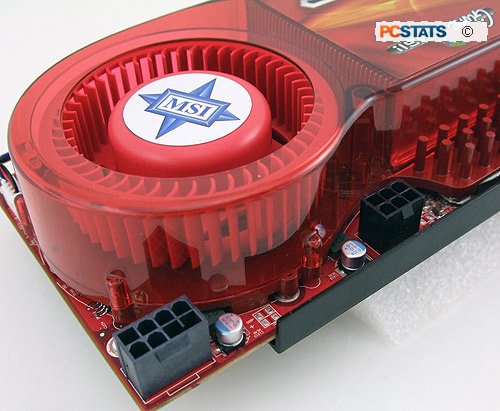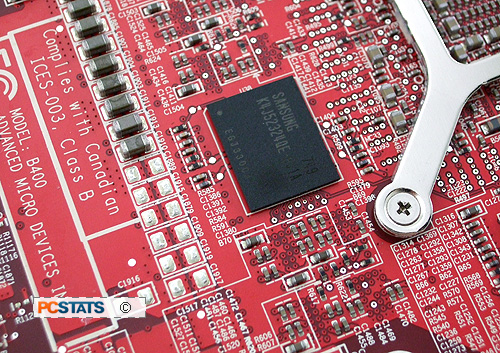 Environmental Green is the trendy new colour to paint yourself
and your company these days, and computer equipment makers have been paying as
much lip-service to the trend as anyone else except in the area of videocards,
where the latest, biggest and baddest gaming cards always Hoover up a huge
amount of power to work correctly.
Environmental Green is the trendy new colour to paint yourself
and your company these days, and computer equipment makers have been paying as
much lip-service to the trend as anyone else except in the area of videocards,
where the latest, biggest and baddest gaming cards always Hoover up a huge
amount of power to work correctly.
With its twin HD 3870 GPUs, the MSI R3870X2-T2D1G-OC
videocard is not going to be the exception here. ATI recommends a
minimum of 550 watts for the HD 3870 X2 videocard, and that's pretty
much where PCSTATS stands also. Don't think of doing the Crossfire thing with a
pair of these cards unless you are packing at least a 750Watt PSU
with quad PCI express power connectors.
The MSI R3870X2-T2D1G-OC uses two PCI-express power
connectors, an eight pin and a six-pin. The 6-pin connectors, like the
PCI-Express x16 slot itself, deliver up to 75W of power. The 8-pin can deliver a
whopping 225W (though the card has been designed to work with two 6-pin connectors
as well). Maximum power draw should hover somewhere around 225W, then.
The only advantage to using a full 8-pin PCI express
power connector is that this will enable the 'overdrive' overclocking features
built into the ATI Catalyst driver suite. Now let's get a look at how much power
the MSI R3870X2-T2D1G-OC actually draws in single and crossfire
configurations.
Videocard Power Draw
Comparisons
Here's how the MSI R3870X2-T2D1G-OC videocard stacks up
in real life against a couple different cards We have no way of directly
measuring video card power draw, so PCSTATS will measure total system power draw
and compare that in 3D loaded (max value recorded in 3DMark06) and idle states
(at Windows desktop). The power supply used in each test is an A-PFC compliant
PC Power and Cooling 750W model.
 Videocard Power Consumption (Total System
Power Draw) Videocard Power Consumption (Total System
Power Draw) |
| Idle at Desktop |
Watts |
Ranking |
| Palit HD4870 X2 2GB |
177 |
   |
| Asus EAH3870 X2 1GB
TOP/G/3DHTI/1G/A |
153 |
   |
 MSI R3870X2-T2D1G-OC MSI R3870X2-T2D1G-OC |
165 |
   |
 MSI R3870X2-T2D1G-OC (Crossfire) MSI R3870X2-T2D1G-OC (Crossfire) |
222 |
   |
| Diamond Viper Radeon HD 2900XT
CrossFire |
195 |
   |
| Asus EAH4850 HTDI/512M |
120 |
   |
| Asus EAX1900XTX 2DHTV/512M/A |
160 |
   |
| Asus EAX1950PRO/HTDP/256M/A |
150 |
   |
| nVidia Geforce 9600GTs in SLI |
166 |
   |
| Asus EN9600GT Top/HTDI/512M |
152 |
   |
| Palit Geforce 9600GT 512 |
151 |
   |
| MSI NX8800GTX-T2D768E |
196 |
   |
| MSI NX7950GX2-T2D1GE |
183 |
   |
| MSI NX7900GTX-T2D512E |
165 |
   |
| Gigabyte GV-NX76T256D-RH |
140 |
   |
| 3D Loaded: |
Watts |
Ranking |
| Palit HD4870 X2 2GB |
421 |
   |
| Asus EAH3870 X2 1GB
TOP/G/3DHTI/1G/A |
390 |
   |
 MSI R3870X2-T2D1G-OC MSI R3870X2-T2D1G-OC |
330 |
   |
 MSI R3870X2-T2D1G-OC (Crossfire) MSI R3870X2-T2D1G-OC (Crossfire) |
610 |
   |
| Diamond Viper Radeon HD 2900XT
CrossFire |
549 |
   |
| Asus EAH4850 HTDI/512M |
202 |
   |
| Asus EAX1900XTX 2DHTV/512M/A |
333 |
   |
| Asus EAX1950PRO/HTDP/256M/A |
252 |
   |
| nVidia Geforce 9600GTs in SLI |
313 |
   |
| Asus EN9600GT Top/HTDI/512M |
220 |
   |
| Palit Geforce 9600GT 512 |
221 |
   |
| MSI NX8800GTX-T2D768E |
345 |
   |
| MSI NX7950GX2-T2D1GE |
315 |
   |
| MSI NX7900GTX-T2D512E |
277 |
   |
| Gigabyte GV-NX76T256D-RH |
213 |
   |
| (Overclocked) 3D Loaded: |
Watts |
Ranking |
| Palit HD4870 X2 2GB |
426 |
   |
 MSI R3870X2-T2D1G-OC MSI R3870X2-T2D1G-OC |
339 |
   |
 MSI R3870X2-T2D1G-OC (Crossfire) MSI R3870X2-T2D1G-OC (Crossfire) |
630 |
   |
| Asus EAH4850 HTDI/512M |
231 |
   | |
At idle, the MSI R3870X2-T2D1G-OC videocard and
test system draw approximately 165W. Energy consumption jumps a lot when the
video cards are stressed under a 3D gaming load in 3DMark06. In this case, the
total system power draw for the MSI R3870X2-T2D1G-OC test platform rises to a peak of about
330W. That's a change of about 245W when this dual card is working at its peak.
Keep in mind that some of this additional power is being drawn by the CPU and
memory. The 550W PSU recommended by AMD might be a slight overkill judging by
these numbers, but we wouldn't want to go much below 500W.
The crossfire setup almost doubles the power usage to a whopping 610W! Your
550W system has now restarted or just blown up in protest, and you are
reconsidering the idea of ignoring the box specs... Seriously, we knew that dual
HD 3870 X2 videocards were going to use a lot of power, but 610W of total
system power draw is impressive. The 750W or greater PSU recommended specs seem
to be accurate as far as PCSTATS is concerned. Overclocking in single or
crossfire setups did not boost the power requirements by any significant
amount.

Now let's have a look at how MSI's dual-core creation
overclocks.
